Sixty-one percent of the population 15 years old and over were in the labor force
In January 2024, Davao Region's total population 15 years old and over was estimated at 3.82 million. The Labor Force Participation Rate (LFPR) in January 2024 was posted at 60.7 percent, lower than the reported LFPR in January 2023 at 63.2 percent and October 2023 at 63.9 percent (see Table 1). The LFPR in January 2024 translates to 2.32 million Davaoeños aged 15 years old and over who were in the labor force, or those who were either employed or unemployed. The number of individuals aged 15 years old and over who were in the labor force in January 2023 was 2.37 million, while 2.42 million were in the labor force in October 2023.
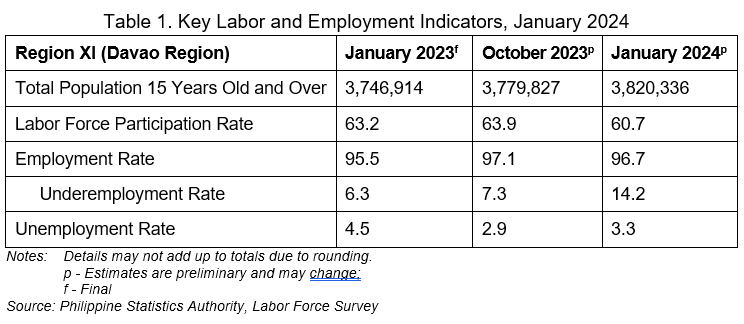
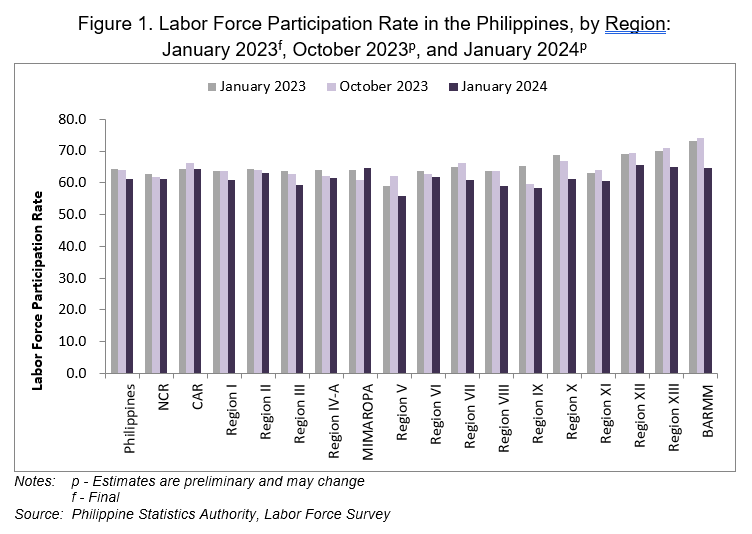
Among the 17 Regions, SOCCSKSARGEN reported the highest LFPR at 65.8 percent, while Bicol Region has the lowest rate at 55.9 percent. Seven regions have lower LFPR than the national estimate of 61.1 percent: Ilocos Region (60.9%), Central Visayas (60.7%), Davao Region (60.7%), Central Luzon (59.3%), Eastern Visayas (59.0%), Zamboanga Peninsula (58.4%), and Bicol Region (55.9%). BARMM has the highest decrease in terms of percentage points from 73.2 percent LFPR in 2023 to 64.5 percent in 2024.
Davao Region’s employment rate at 96.7 percent among regions
Employment rate or the proportion of employed persons of the total labor force in Davao Region was at 96.7 percent in January 2024. This was higher than the employment rate in January 2023 at 95.5 percent but lower than the recorded employment rate in October 2023 at 97.1 percent. However, in terms of levels, the number of employed persons in January 2024 was posted at 2.24 million, lower than the number of employed persons in the same month last year at 2.26 million. In October 2023, the number of employed persons was estimated at 2.34 million.
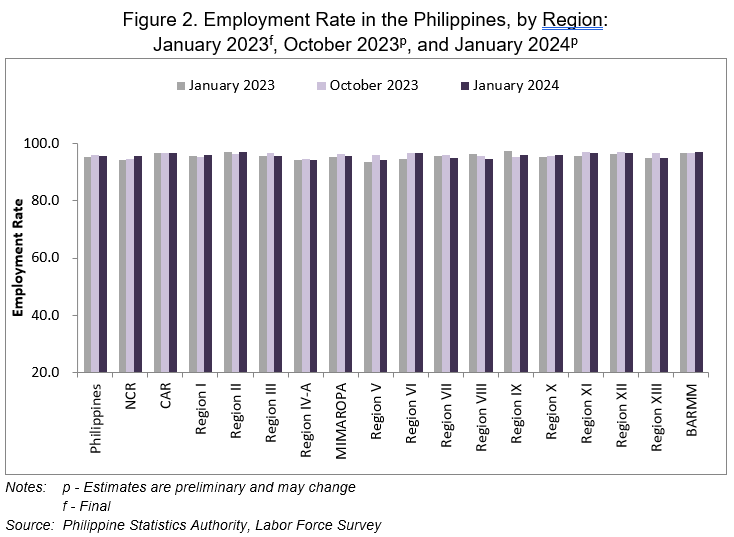
Davao Region's employment rate for January 2024 was higher than the national estimate of 95.5 percent. Ten other regions recorded higher employment rate compared to the national employment rate: BARMM (97.1%), Cagayan Valley (97.1%), SOCCSKSARGEN (96.7%), CAR (96.7%), Western Visayas (96.5%), Zamboanga Peninsula (96.1%), Ilocos Region (96.0%), Northern Mindanao (95.8%), Central Luzon (95.7%) and MIMAROPA (95.6%). Eastern Visayas showed the highest decrease of 1.6 percentage points from January 2023 at 96.2 percent to January 2024 at 94.6 percent.
Unemployment rate was recorded at 3.3 percent
Unemployment rate of Davao Region in January 2024 dropped to 3.3 percent, from 4.5 percent in the same month of the previous year. Unemployment rate in October 2023 was recorded at 2.9 percent. In terms of magnitude, the number of unemployed individuals in January 2024 was estimated at 76 thousand. This was lower than the reported number unemployed persons in January 2023 of 107 thousand, but higher than what was reported in October 2023 of 70 thousand.
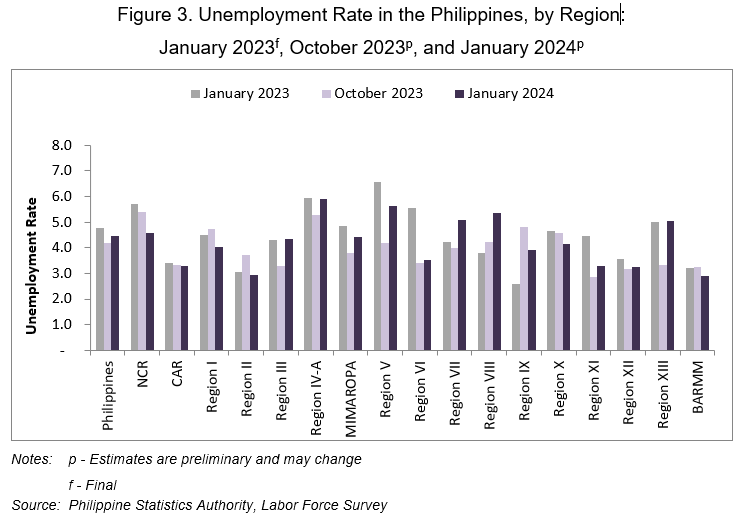
Unemployment rate in six regions of the country reporting higher than the national estimate of 4.5 percent in January 2024 were: CALABARZON (5.9%), Bicol Region (5.6%), Eastern Visayas (5.4%), Central Visayas (5.1%), Caraga (5.1%) and NCR (4.6%).
Davao Region’s Underemployment rate is at 14.2 percent
In January 2024, 14.2 percent of total employed Davaoeños reported to be underemployed. This is higher than the recorded rates in January 2023 of 6.3 percent and October 2023 of 7.3 percent. In terms of magnitude, about 329 thousand of the 2.24 million employed individuals expressed the desire to have additional hours of work in their present job or to have additional job, or to have a new job with longer hours of work in January 2024.
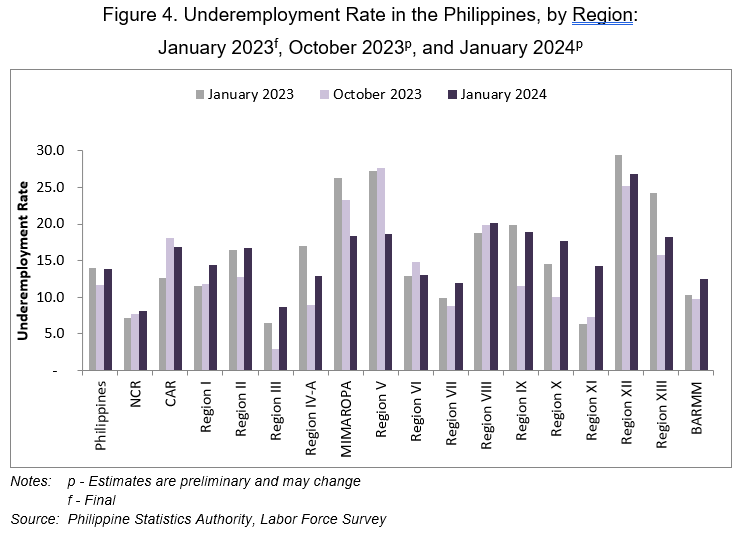
SOCCSKSARGEN has the highest underemployment rate with 26.8 percent, 12.9 percentage points higher than the national estimate. Ten other regions with underemployment rate higher than the national estimate of 13.9 percent were: Eastern Visayas (20.2%), Zamboanga Peninsula (18.9%), Bicol Region (18.7%), MIMAROPA (18.4%), Caraga (18.3%), Northern Mindanao (17.6%), CAR (16.8%), Cagayan Valley (16.8%), Ilocos Region (14.4%) and Davao Region (14.2%).
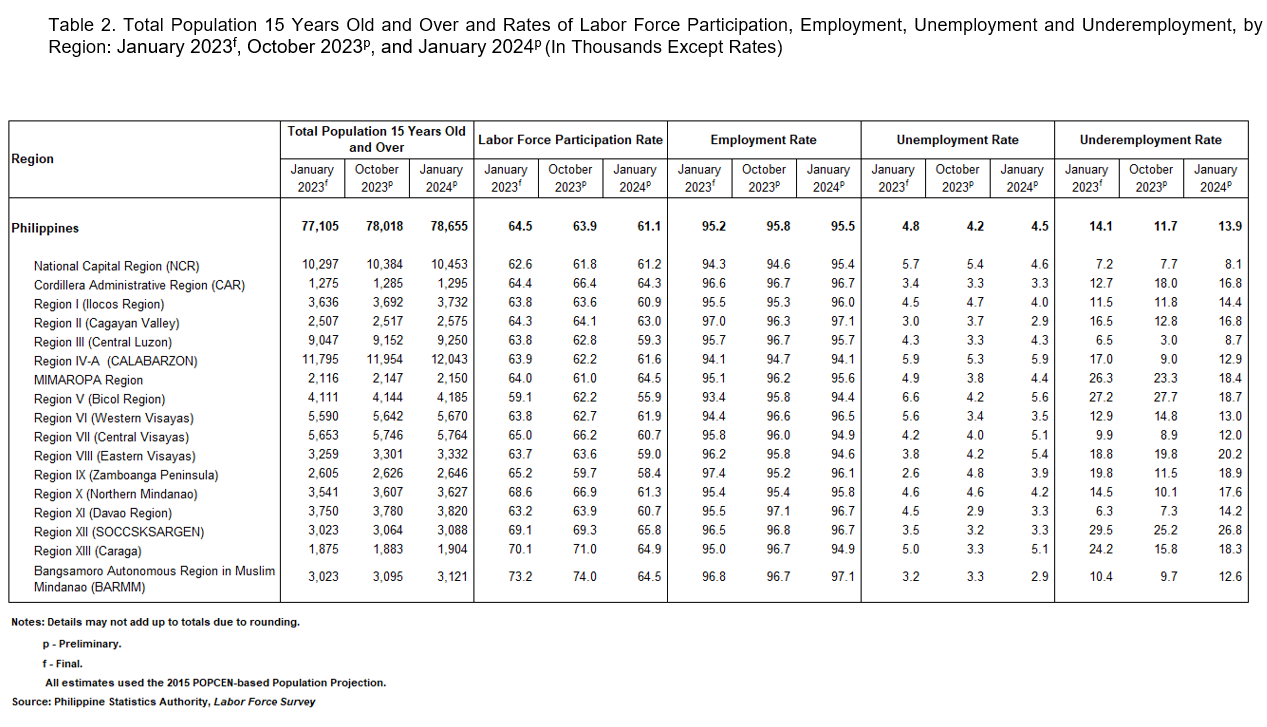
Technical Notes
• The Labor Force Survey (LFS) is a vehicle to gather such data on the demographic and socio-economic characteristics of the population with nationwide coverage and conducted on a quarterly and monthly mode by interviewing households. The Philippine Statistics Authority (PSA) implements the LFS.
• The survey is designed to provide statistics on levels and trends of employment, unemployment, and underemployment for the country, as a whole, and for each of the administrative regions.
• The reference period for this survey is the “past week” referring to the past seven days preceding the date of visit of the enumerator or the field interviewer.
• The population projections based on the 2015 Population Census (POPCEN 2015) has been adopted to generate the labor force statistics. For comparability, population projections based on the POPCEN 2015 was likewise used in the October 2019 labor force statistics.
• Starting April 2012 LFS, the codes for industry adopted the 2009 Philippine Standard Industrial Classification (PSIC). Prior to this, codes for industry used the 1994 PSIC. The 2012 Philippine Standard Occupational Classification (PSOC) was adopted starting April 2016. The 1992 PSOC had been used prior to these rounds.
• In the April 2017 round of the LFS, Computer Aided Personal Interviewing (CAPI) using Tablet was utilized in the enumeration.
• Overseas Filipino Workers are not considered part of the labor force in the Philippines. Hence, in the LFS, data on economic characteristics of household members who are overseas workers are not collected. In the LFS reports, they are excluded in the estimation of the size of working population, that is, population aged 15 years and older, and in the estimation of the labor force.
APPROVED FOR RELEASE:
RANDOLPH ANTHONY B. GALES
(Chief Statistical Specialist)
Officer-In-Charge
Regional Statistical Services Office XI
